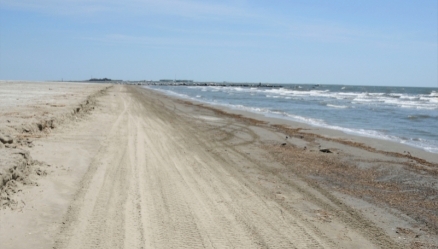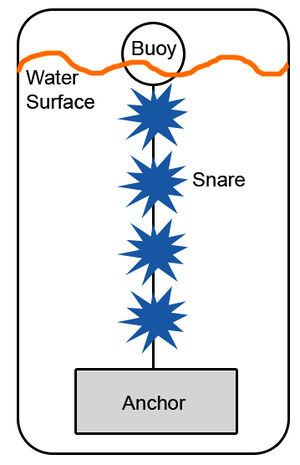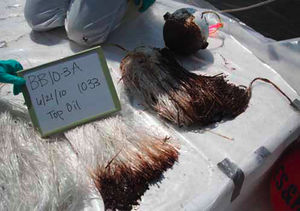Near shore submerged oil assessment
Contents
Overview
In the context of the BP Deepwater Horizon oil spill in the Gulf of Mexico, submerged oil refers to near shore oil which has picked up sediments and become heavier than water and sunk. Without the addition of these sediments, extensive laboratory study has shown that this particular oil will not sink. The oil can be visible to the naked eye, but is not always easy to locate as it may be covered by sand and sediment, or in deeper water. Although it is common to use the terms submerged and subsurface interchangeably, they are actually distinct and result from very different physical and chemical processes.
In this spill, the oil was released more than 5,000 feet below the surface and some was either naturally or chemically dispersed in the process of degrading (Natural oil degradation processes). Some of it rose to the surface and formed “slicks” and a smaller amount of it remained dispersed in the water column in the deep ocean as tiny droplets, most too small to be seen by the naked eye, to be consumed by naturally occurring bacteria. This remaining oil is referred to as subsurface oil. The rest of this fact sheet is about submerged oil and reflects sampling results to date.
Things you should know about submerged oil
1. Submerged oil is relatively uncommon: Deepwater Horizon oil is a light crude oil that floats. In some cases, weathered oil encounters sand or other types of sediment and organic debris that weigh it down and it sinks to the bottom in the very near shore and surf zone.
2. Submerged oil can be difficult to find: it can be covered by sediments; it can be in deeper or cloudy water and there are many things that look like submerged oil which are not, for example, sea grasses or organic matter.
3. Submerged oil can be difficult to recover: it requires significant skill to remove without risking response personnel and additional environmental impact.
Submerged oil is mostly in very near shore areas and the sampling to date confirms that Deepwater Horizon oil has been submerged only after being mixed with sand or other types of sediment or organic matter heavier than seawater. This is usually a result of waves moving oil over sandy areas.
Weathered oil (oil that has been exposed to the elements for days or weeks) can become sticky and is more susceptible to picking up small particles, adding enough weight to sink the oil. During the Deepwater Horizon spill response, as with most spills, there have been many reports of submerged oil, many of these end up being false, due to things like sargassum, algae and diatom blooms, being mistakenly thought to be submerged oil. Accurately identifying oil has always been a challenge during oil spills.
Deepwater Horizon programs to detect submerged oil
To address ongoing concerns about submerged oil, the Unified Area Command has implemented sampling, in the nearshore (depths of less than 200 ft deep) and in the deep water. The sampling has been carried out by NOAA (National Oceanic and Atmospheric Administration (NOAA), United States), EPA, BP, and academic and consultant scientists, directed by the Unified Area Command, using both research vessels and vessels of opportunity.
Sampling teams are towing nets to detect and capture tar balls, taking water column and sediment samples at a variety of depths, placing sorbent material in the water column to detect any oil that might be carried toward land by currents and even deployed teams of skin divers to survey in the shallow water. Such measures are necessary because submerged oil can be very difficult to locate. However, because of the intensity and variety of sampling, we are becoming more confident that we understand the conditions under which this oil will submerge, the location we expect it to happen and extent it has happened.
The Unified Area Command has directed response scientists to:
- Define the extent of submerged oil by systematic surveys
- Aggressively sample those areas where submerged oil is reported
- Comprehensively sample water and sediments where submerged oil might be suspected
Submerged oil monitoring programs currently underway in the Gulf include:
- EPA surveys to collect water and sediment samples from locations along the Louisiana coast and later expand to collect mid-water column samples.
- Programs using nets to detect and capture tar balls and submerged oil. These programs are systematic and responsive, following a design and investigating individual reports (for example if someone reports having pulled up oil on an anchor).
- Deployment and regular checking of snare sentinels that indicate the presence or absence of submerged oil.
Forms of Deepwater Horizon submerged oil
At this time, Deepwater Horizon response scientists have seen the following forms of submerged oil:
- patches of weathered oil that landed on sandy beaches, picked up sand and then were moved off the beach into the nearshore shallow water by waves as mats or rollers;
- weathered oil that mixed with sand as a result of waves breaking on offshore sand bars, then sank to low areas between sandbars (observed off Alabama); and
- in sheltered inshore bays, small bits of oil that are on or below the surface stuck to sediments and organic matter, then accumulated on the muddy bottom.


